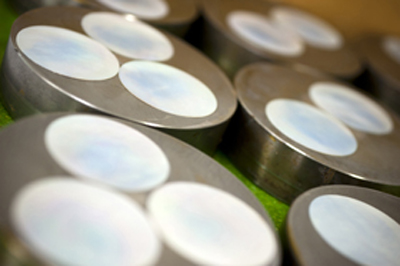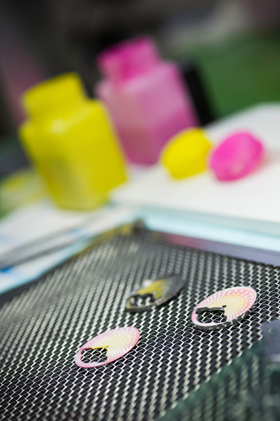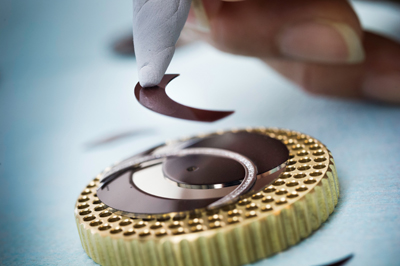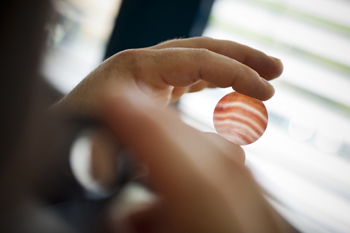
Sowind Mother of pearl dial disks being readied for work.photograph by “picture : patriceschreyer.com”.
Many brands today use mother of pearl for dials on both women’s and men’s watches. Shimmering and intriguing, mother of pearl is not an easy substance to work with. It is quite brittle and ultra thin when used as a dial and breakage can easily occur. Depending on the complexity of the dial, the entire production process involves 15 different artisan steps and takes between four and six weeks. A company such as GT Cadran, with 20 specialized dial makers, can only produce about 5,000 mother-of-pearl dials annually. Here, we show eight elaborate steps in the making of natural mother-of-pearl dials.
Shell selection plays a role, especially at the very high end of the watchmaking spectrum. Top-quality shells come in extra-white colors and often are from Australia. Though shells also hail from other parts of the world. To make the thin mother-of-pearl dials, thick discs are cut from the shell. These thick discs are then thinned out and polished using a series of wheels to achieve the desired thinness. In the end, the dials are precisely machined into thin layers that are typically 0.2mm. From these thin sheets of mother of pearl, CNC machines cut perfect round orbs or specifically shaped pieces that will serve as the dial for certain watches.

Applying color to the dial back of a Girard-Perregaux dial. photograph by “picture : patriceschreyer.com”.
Due to machining capabilities, many dial makers buy the disks already cut and start the work from there. From this point forward, mother-of-pearl dials are largely hand crafted. Each dial orb is carefully inspected. Mother-of-pearl dials can be engraved or finished with all sorts of patterns from traditional sunray to decorative motifs. This is all delicately done by hand on either the dial front or back depending on the design.
Dials can be enhanced in color by painting, varnishing or lacquering the back of the mother of pearl. Generally, mother of pearl has a milky white luster, however it can be found with a natural pearlescent hue in pale blue, pink, gray and brown.

Inlaying of mother of pearl and gold for marquetry dials. photograph by “picture : patriceschreyer.com”.
Polishing is an important step, as it brings out the natural luster of the shell.Generally, numerals and markers are then inked onto the dial, or cut-outs are made on the dial for the setting of gemstones or applied indices. Further embellishments are then set into place, such as diamonds, gemstones or ribbons of gold and the hands are added.







What do you mean when you say the “shells are crushed?” Are they crushed into fine pieces and epoxied together and then machined? Or something else? Also, what’s the story on black mother of pearl? I assume the dials are dyed sometime in the process.
The shells are crushed and then ground into fine, thin sheets to be cut; black mother-of-pearl can occur naturally and is usually a bit more gray than pure black. Many affordable brands lacquer the backs of their mother of pearl to achieve a richer, darker black hue. thanks for asking.
I just purchased a Raymond Weil watch for my wife and the mother of pearl face has some slight bubbling or ripples. I didn’t know if this is natural but it sounds like it’s a flaw. I don’t particularly like the effect.
Mother of pearl naturally has shimmers and what could be viewed as “rippled” but it is smooth and beautiful. if you have bubbles you should take it back to the jeweler/retailer you bought it from and exchange it.
I submitted a “as good as new” Omega ladies Constellation watch for repair (it just stoped). Now I am informed that the mother of pearl dial is cracked and needs replacement. My wife is extremely carfull with her jewelry and the watch was NEVER abused and is kept in a safe to be used on special occasions only. I am of the opinion that the only possible cause for a MOP dial to crack is either during manufacturing, which is then a latent defect or else during disassembly to do the repairs. I need to know if this is a frequent occurrence that MOP dials crack? And what is you opinion on this issue?
mother of pearl dials are fragile. They are paper thin and, depending on the dial, can have drill holes for the numerals. Was the service center an authorized Omega service center? If so, you should talk with them, if not, you might try speaking to the technical center for the Swatch Group, of which Omega is a division.
The mother of pearl is not crushed before being manufactured into watch dials. Thick discs are cut from the shell which are then sawn into thinner discs. They are then polished using a series of honing and polishing wheels until the desired thickness is achieved. They are extremely thin and are therefore susceptible to cracking at this stage. However, once they have been secured to the watch dial itself, they should not crack. The polishing process allows a very high degree of accuracy. They are flat to within 0.02mm allowing a perfect bond with the underlying watch dial. This provides support for the entire MOP surface and prevents cracking. If an MOP dial has a crack it is most likely that it occurred during the watch’s assembly.
thank you for your input == i will ammend accordingly … appreciate it.